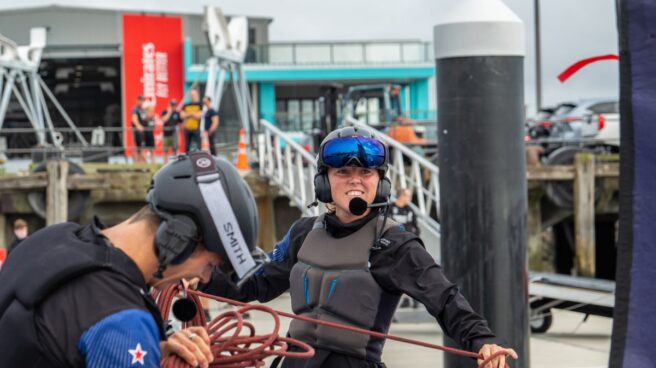

Liv McKay on her debut at the controls of one of the AC40s
in 2024 In the waters of the port of Fronte Maritim in Barcelona, for the first time, women’s sailing competitions for the America’s Cup will be held. An unprecedented milestone showing the growing role of women in the world of sports in general and the oldest trophy on the planet, which is also one of the top three sports events with the highest global audience in particular.
Along with the athletes themselves, There are also women in the institutional and executive sphere who already hold important leadership positions. The event’s host company, ACE Barcelona, has Vice President Aurora Kata and Organizing Director Lesley Ryan as two leading figures.
In addition, with the recent launch of the first AC40-class vessels, the role of engineers, data analysts and skippers of participating teamsand offer a preview of what the first edition of the Women’s America’s Cup will bring.
This is the case Liv McKay, one of the first sailors to take the helm of the AC40.the designated official boat for the Women’s America’s Cup. After excellent results in Olympic classes such as 49erFX or Nacra17, the New Zealander trained and competed in the Emirates Team New Zealand in-water test and development program.
After a short adaptation period McKay was able to enjoy his first practice aboard one of the two AC40 Defender of the America’s Cup. “It’s incredible, I never get tired of sailing,” he admitted after more than an hour and a half debut at the helm, which was a key moment, followed by two “tense” weeks, during which “the learning curve went very quickly.” “.
The training that more and more women’s America’s Cup participants will continue to experienceas the AC40 fleet grows among America’s Cup teams that have recently launched their boats such as Alinghi Red Bull Racing in Barcelona, Ineos Britannia in Palma and American Magic in the United States.
Before talking about the women’s America’s Cup monocoque as “very fun, kart-like” boat, McKay hopes to put all the experience gained during this program to good use. not only to ensure their presence on the final roster that will travel to Barcelona, but also to continue to provide the New Zealand ground teams with the best information on the ground.
two way road
In this design, designed so that sportsmen like McKay can get the most out of their boats, there are two engineers who already know what it means to lift a hundred guinea pitcher at least once, and whose daily activities in setting up to onshore AC75 and monohulls AC40 is critical. This is his compatriot Elise Beavis and American Kelly Hartzell.
Mechatronics engineer by profession, Hartzel is one of those responsible for “calibrate” and “translate the raw sensor data” from each vessel into numbers “that make sense to us”as he admitted to the New Zealand press. Born and raised in the mountains of Colorado, Emirates Team New Zealand was introduced to the destination during a sabbatical with a partner in New Zealand and after early professional experience developing 4WD systems for Ford in Michigan.
It was there that he fell in love with sailing after a call from a couple of colleagues who were looking for a crew for the regatta. More than five years later, thousands of miles from my home, The American has found a new source of inspiration: her partner Elise.
In addition to working on the America’s Cup Defender design team, Beavis rediscovered sailing while working as a performance engineer for Emirates Team New Zealand and most notably through crowned world champion in the WASZP single training foil class.
“He’s an amazing person,” Hartzell says of Beavis. “Often we claimed a place in the forward cabin of the boat as our small workplace. And we joke that this is a women’s place on the ship.
Source: El Independiente